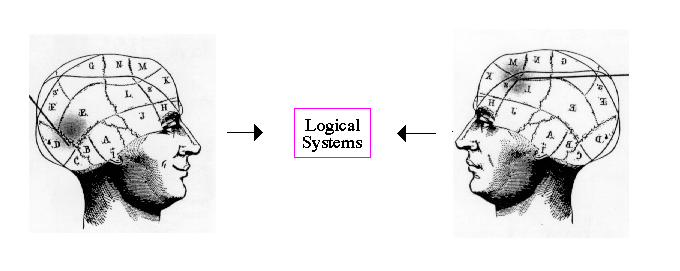
|
The main purpose of science is to trace, within the chaos and flux of phenomena, a consistent structure with order and meaning. This is called the philosophy of rationalism, rational as in conforming with reason. And the purpose of scientific understanding is to coordinate our experiences and bring them into a logical system. |

|
..
|
.. Thoughout history, intellectual scientific efforts have been directed towards the discovery of pattern, system and structure, with a special emphasis on order. Why? Primarily, the control of the unpredictable driven by the fear of the unknown. Those who pursue answers are known as scientists. The main occupation of a scientist is problem solving with the goal of understanding the Universe. .. Science is founded on the hope that the world is rational in all its observable aspects. Its possible that there may be some facets of reality which lie beyond the power of human reasoning, that there may be things with explanations that we could never grasp, or no explanation at all, but the fact that the world is rational is connected with the fact that it is ordered. |
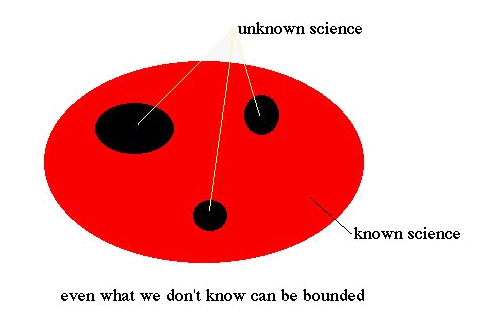
|
..
|
.. Science is also a dialogue between mankind and Nature. Science is far from a perfect instrument of knowledge, but it provides something that other philosophies fail to, concrete results. Science is a "candle in the dark" to illuminate irrational beliefs or superstitions. Science does not, by itself, advocate courses of human action, but it can certainly illuminate the possible consequences of alternative courses. In this regard, science is both imaginative and disciplined, which is central to its power of prediction. .. How does science differ from art? Both use imagination and creativity, but art is free and unconstrained. Ideas in science must conform with experimentation and observation. In other words, science can be tested and must conform to Nature (i.e. reality). Although we note that this statement gets fuzzy when discussing quantum physics. .. Science is
any system of knowledge that is concerned with the physical world and its
phenomena and entails unbiased observations and/or systematic
experimentation. In general, a science involves a pursuit of knowledge
covering general truths or the operations of fundamental laws of
nature.
|
Scientific Method:
|
Aristotle believed that scientific knowledge
comes from the logical inferences built from indisputable, self-evident
truths. But where do those truths come from? Aristotle's answer was that
we induce them.
.. Induction is the acquiring of knowledge from our senses. Thus, induction became the dominant method of science for 2000 years. Today we recognize that there are two types of science, rational and empirical. .. Rational refers to statements coming from ideas, while empirical refers to science based on observations. Rational science is about ideas, whereas empirical science is about experiences connected to the real world. .. Rational science starts from self-evident truths and moves by rigorous logical arguments to a conclusion about some new truth, this is called deduction. .. Empirical science starts from a hypothesis which implies a tentative truth, and uses multiple observations to reach a conclusion about the truth of the original hypothesis, this is called induction. .. Scientific arguments of logic basically take on four possible forms; .. 1) the pure method of deduction, where some conclusion is drawn from a set of propositions (i.e. pure logic), .. 2) the method of induction, where one draws general conclusions from particular facts that appear to serve as evidence, .. 3) by probability, which passes from frequencies within a known domain to conclusions of stated likelihood, and .. 4) by statistical reasoning, which concludes that, on the average, a certain percentage of a set of entities will satisfy the stated conditions. |
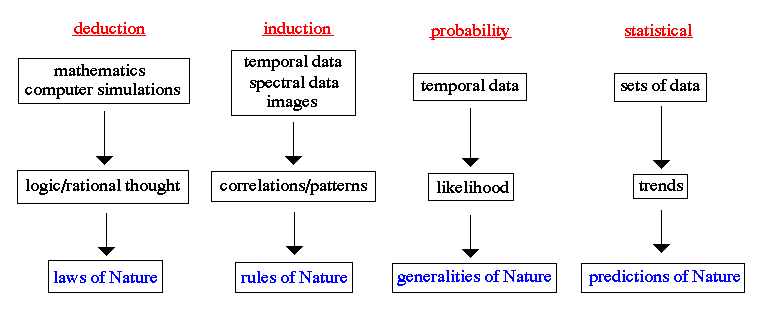
.. |
.. The fact that scientific reasoning is so often successful is a remarkable property of th e Universe, the dependability of Nature. .. To support these methods, a scientist also uses a large amount of skepticism to search for any fallacies in hypothesis or scientific arguments. In order to draw conclusions, a scientist uses the scientific method, a rigorous standard of procedure and discussion that sets reason over irrational belief. Central to the scientific method is a system of logic. .. Note that there is an emphasis on falsification, not verification. If a theory passes any test then our confidence in the theory is reinforced, but it is never proven correct in a mathematically sense. Thus, a powerful hypothesis is one that is highly vulnerable to falsification and that can be tested in many ways. |
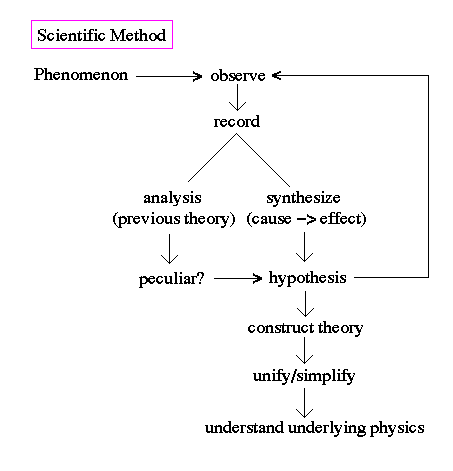
|
Newtonian or classical physics, and all
sciences derived from physics, rests squarely on the principle of locality,
the idea that correlated events are related by a chain of causation.
.. The necessary connection in cause and effect events is the exchange of energy, which is the foundation of information theory => knowledge is power (energy). .. Also key to cause and effect is the concept that an object's existence and properties are independent of the observation or experiment and rooted in the material reality of Nature. |
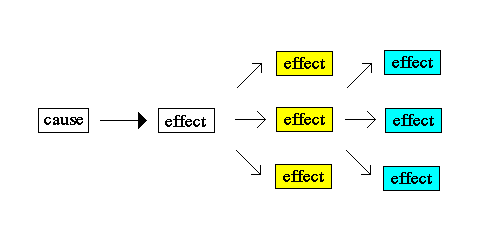

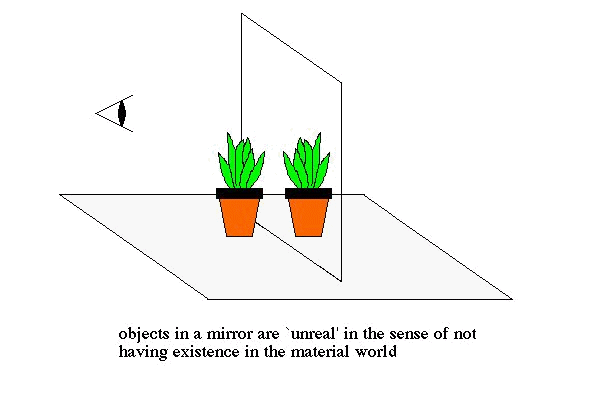
.. |
.. Causal links build an existence of patterns that are a manifestation of the Universe's rational order. Does the chain of cause and effect ever end? Is there an `Initial Cause'? |
|
Reductionism
is the belief that any complex set of phenomena can be defined or
explained in terms of a relatively few simple or primitive ones.
.. For example, atomism is a form of reductionism in that it holds that everything in the Universe can be broken down into a few simple entities (elementary particles) and laws and interactions among them. Modern chemistry reduces chemical properties to ninety or so basic elements (kinds of atoms) and their rules of combination. .. To a reductionist, once a set of equations or mathematical relations has been found to describe a system, then the behavior of the system is considered to be explained. |
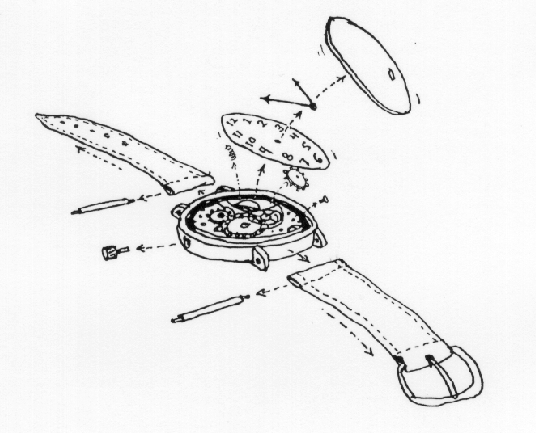
.. |
.. Reductionism is very similar to, and has its roots from, Occam's Razor, which states that between competing ideas, the simplest theory that fits the facts of a problem is the one that should be selected. .. Reductionism was widely accepted due to its power in prediction and formulation. It is, at least, a good approximation of the macroscopic world (although it is completely wrong for the microscope world, see quantum physics). .. Too much success is a dangerous thing since the reductionist philosophy led to a wider paradigm, the methodology of scientism, the view that everything can and should be reduced to the properties of matter (materialism) such that emotion, aesthetics and religious experience can be reduced to biological instinct, chemical imbalances in the brain, etc. The 20th century reaction against reductionism is relativism. Modern science is somewhere in between. |
|
Closely associated with reductionism is
determinism, the philosophy that everything has a cause, and that a
particular cause leads to a unique effect. Another way of stating this is
that for everything that happens there are conditions such that, given
them, nothing else could happen.
.. Determinism is the theory that all events, including moral choices, are completely determined by previously existing causes that preclude free will and the possibility that humans could have acted otherwise. .. The theory holds that the Universe is utterly rational because complete knowledge of any given situation assures that unerring knowledge of its future is also possible. .. Pierre-Simon, Marquis de Laplace, in the 18th century framed the classical formulation of this thesis. For him, the present state of the Universe is the effect of its previous state and the cause of the state that follows it. If a mind, at any given moment, could know all of the forces operating in nature and the respective positions of all its components, it would thereby know with certainty the future and the past of every entity, large or small. .. The Persian poet Omar Khayyam expressed a similar deterministic view of the world in the concluding half of one of his quatrains: "And the first Morning of Creation wrote / What the Last Dawn of Reckoning shall read." .. Indeterminism, on the other hand, though not denying the influence of behavioral patterns and certain extrinsic forces on human actions, insists on the reality of free choice. Exponents of determinism strive to defend their theory as compatible with moral responsibility by saying, for example, that evil results of certain actions can be foreseen, and this in itself imposes moral responsibility and creates a deterrent external cause that can influence actions. |

.. |
.. Implicit to determinism is the fact that every event happens of necessity. It has to happen; the Universe has no choice. .. Determinism also implies that everything is predictable given enough information. Since Newtonian or classical physics is rigidly determinist, both in the predictions of its equations and its foundations, then there is no room for chance, surprise and creativity. Everything is as it has to be, which gave rise to the concept of a clockwork Universe. |
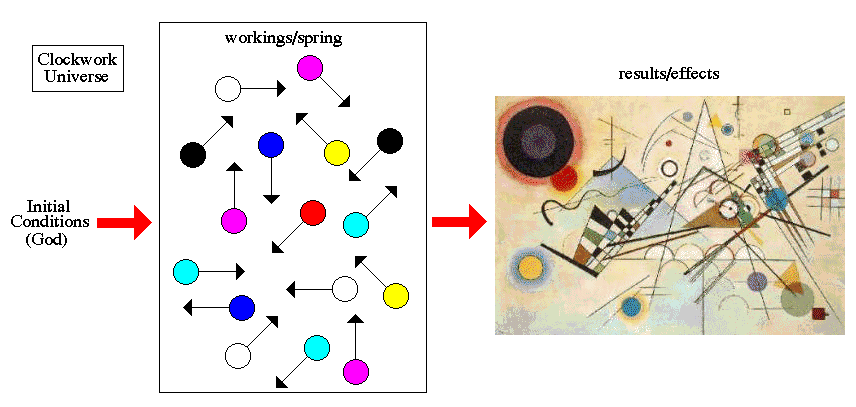
|
The rise of science during the Age of Reason produced the idea that there is a hidden order in Nature, which is mathematical in form and could be uncovered by investigation. This hidden order could be expressed in the form of mathematical principles, or laws of Nature. |
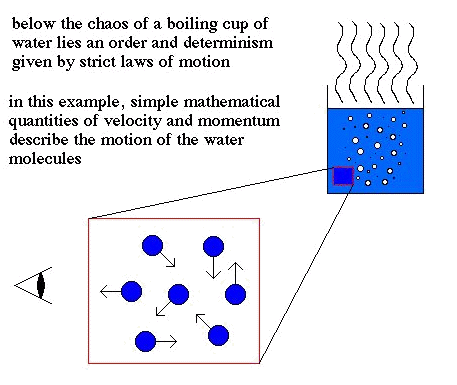
.. |
.. Direct connections between events are usually apparent to the senses. But the underlying causes associated with the laws of Nature are much more subtle. Observations of events are not generally intelligible. Often phenomenon requires an abstract theoretical framework to form a context for measurements in order to link them into a framework of understanding. This framework is called a scientific theory. |
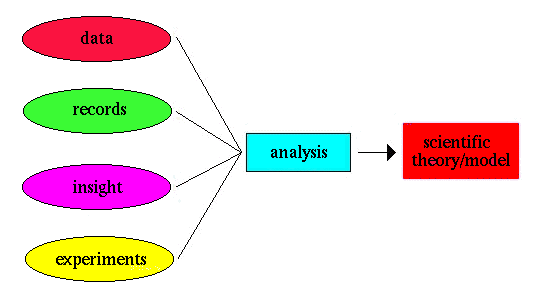
.. |
.. The laws of Nature are attempts to capture the regularities of the world systematically. The existence of regularities in Nature is an objective fact, thus we do not impose laws onto Nature. While the form of the laws are human inventions, they reflect, albeit imperfectly, real properties in Nature. It is this absolute invariance of the laws of Nature that underwrites the meaningfulness of the scientific enterprise and assured its success. |
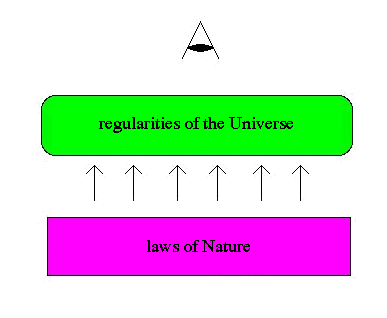
.. |
.. Truly basic laws of Nature establish deep connections between different physical processes. When a new law is developed, it is tested under different contexts which often leads to the discovery of new, unexpected phenomena. This demonstrates that we are determining real regularities in Nature, not imposing them with our scientific structures. .. The laws of Nature are eternal, absolute and have an independent existence outside the physical conditions of an experiment. Success in the scientific method rests on the reproducibility of the results. An experiment is repeated and the same laws of Nature apply, but the initial conditions of the experiment can be varied. There is a clear functional separation between laws and initial conditions, similar to the Platonic Forms. .. If Shakespeare, Beethoven, or van Gogh had not been born its unlikely that anyone else would have ever achieved what they did. But is this true for scientists? Would someone else have discovered the classical laws of motion if there had been no Newton? Probably, because science is a collective enterprise. The solution to a scientific problem must satisfy exacting criteria and demands. These constraints do not eliminate creativity, they provoke it. |
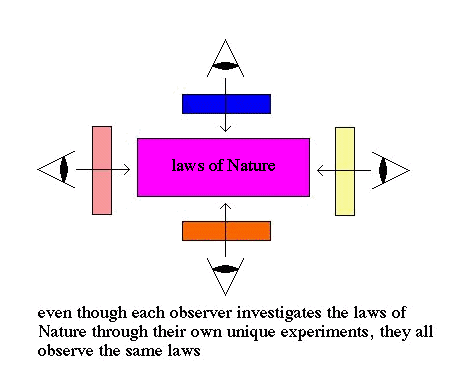
|
Scientific theories are essentially models of the real world (or parts of it) and the vocabulary of science concerns the models rather than reality. Often when the term `discover' is used in a scientific model or theory (such as the discovery of Hawking radiation) this, in fact, refers to a mathematical relationship that is revealed. A true discovery would refer to the observation of the phenomenon in Nature (with respect to Hawking radiation, no one has yet directly observed a black hole). |
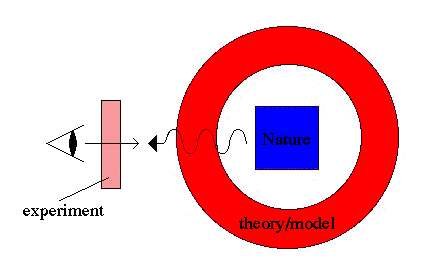
.. |
.. The relationship between a theory or model and the real system represents an important distinction. For example, how do we know when a model is merely a computational device and when does it actually describe reality? Scientific theories are descriptions of reality, they do not constitute that reality. As long as a theory sticks close to direct experience, where common sense remains a reliable guide, then there is confidence that we can distinguish between the theory and reality. Advance theories in modern physics push this boundary, for example, the use of virtual particles in quantum physics. Their existence is never directly observed, so some might say that there use is a simple way of describing an unimaginable process in familiar terms. .. Models or theories that are broad and encompass a significant fraction of a field of science are called paradigms. Reductionism was one of the founding paradigms of science, but was not a complete expression of the truth to Nature. However, the three hundred years of progress that accompanied reductionism was not rooted on a misconception, for this is not the role of paradigms. Rather a particular paradigm is neither right nor wrong, but merely reflects a perspective, an aspect of reality that may prove more or less fruitful depending on the circumstances. Science may not deliver the whole truth, but it certainly deals with truth and not dogma. |
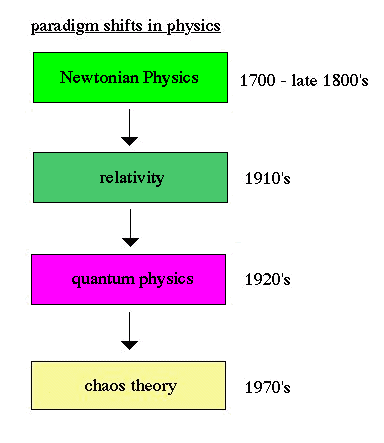
.. |
.. Science historian, Thomas Kuhn, argued that science moved in leaps. That paradigm's form, led to many new discoveries, then become the standard in which new ideas are tested. Eventually, some new experiment or observation will not fit into the current paradigm and will led to a new theory, usually by some brilliant, young scientist. This new theory undergoes a series of phases from disbelief to grudging acceptance until it forms the next paradigm. Each paradigm shift, or science revolution, leads to a major step forward in our understanding of the underlying reality. |
|
Given the tremendous advances in our
understanding of the workings of Nature during the 20th century, the
question arises whether there is the possibility that there is an end of
science, meaning the complete scientific description of all things. There
are two views on this question.
.. One view is that a complete description is indeed possible and that the fundamental questions will one day be answered. Thus, physics becomes a matter of technological advances. .. The second view is that Nature is inexhaustible and infinitely subtle, so that the dialogue between human consciousness and the Universe will never end. .. While there is some merit to the idea that we construct much of the mathematical description of science (see next lecture), that description appears to apply to an objective reality which we test our mathematical principles and laws. While we may refine our descriptions, theories and models, does this reach the point of simply fine tuning? .. We have also noticed a trend in the last few years where our questions about Nature have exceeded our ability to test our ideas. The triumph of modern physics lies in its ability to pose such fundamental questions in a rational, mathematical way. That such questions have a formal meaning is a considerable achievement of the human mind. But some questions, particularly those involving subatomic effects and the physics of the early Universe are not testable in the normal scientific manner. .. This has lead to a division of science into empirical science (one that uses the scientific method) and, what is called, ironic science. Ironic science does not provide any testable conclusions, but rather judges the merit of its ideas on aesthetics criteria (how complete a theory is in a mathematical sense). .. If empirical science ends some day, it is unclear whether ironic science, based on creativity ideas will ever end. |

